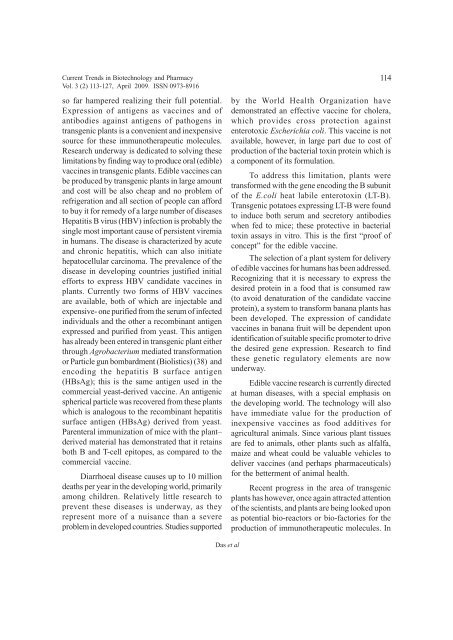April Journal-2009.p65 - Association of Biotechnology and Pharmacy
April Journal-2009.p65 - Association of Biotechnology and Pharmacy
April Journal-2009.p65 - Association of Biotechnology and Pharmacy
You also want an ePaper? Increase the reach of your titles
YUMPU automatically turns print PDFs into web optimized ePapers that Google loves.
Current Trends in <strong>Biotechnology</strong> <strong>and</strong> <strong>Pharmacy</strong><br />
Vol. 3 (2) 113-127, <strong>April</strong> 2009. ISSN 0973-8916<br />
so far hampered realizing their full potential.<br />
Expression <strong>of</strong> antigens as vaccines <strong>and</strong> <strong>of</strong><br />
antibodies against antigens <strong>of</strong> pathogens in<br />
transgenic plants is a convenient <strong>and</strong> inexpensive<br />
source for these immunotherapeutic molecules.<br />
Research underway is dedicated to solving these<br />
limitations by finding way to produce oral (edible)<br />
vaccines in transgenic plants. Edible vaccines can<br />
be produced by transgenic plants in large amount<br />
<strong>and</strong> cost will be also cheap <strong>and</strong> no problem <strong>of</strong><br />
refrigeration <strong>and</strong> all section <strong>of</strong> people can afford<br />
to buy it for remedy <strong>of</strong> a large number <strong>of</strong> diseases<br />
Hepatitis B virus (HBV) infection is probably the<br />
single most important cause <strong>of</strong> persistent viremia<br />
in humans. The disease is characterized by acute<br />
<strong>and</strong> chronic hepatitis, which can also initiate<br />
hepatocellular carcinoma. The prevalence <strong>of</strong> the<br />
disease in developing countries justified initial<br />
efforts to express HBV c<strong>and</strong>idate vaccines in<br />
plants. Currently two forms <strong>of</strong> HBV vaccines<br />
are available, both <strong>of</strong> which are injectable <strong>and</strong><br />
expensive- one purified from the serum <strong>of</strong> infected<br />
individuals <strong>and</strong> the other a recombinant antigen<br />
expressed <strong>and</strong> purified from yeast. This antigen<br />
has already been entered in transgenic plant either<br />
through Agrobacterium mediated transformation<br />
or Particle gun bombardment (Biolistics) (38) <strong>and</strong><br />
encoding the hepatitis B surface antigen<br />
(HBsAg); this is the same antigen used in the<br />
commercial yeast-derived vaccine. An antigenic<br />
spherical particle was recovered from these plants<br />
which is analogous to the recombinant hepatitis<br />
surface antigen (HBsAg) derived from yeast.<br />
Parenteral immunization <strong>of</strong> mice with the plant–<br />
derived material has demonstrated that it retains<br />
both B <strong>and</strong> T-cell epitopes, as compared to the<br />
commercial vaccine.<br />
Diarrhoeal disease causes up to 10 million<br />
deaths per year in the developing world, primarily<br />
among children. Relatively little research to<br />
prevent these diseases is underway, as they<br />
represent more <strong>of</strong> a nuisance than a severe<br />
problem in developed countries. Studies supported<br />
114<br />
by the World Health Organization have<br />
demonstrated an effective vaccine for cholera,<br />
which provides cross protection against<br />
enterotoxic Escherichia coli. This vaccine is not<br />
available, however, in large part due to cost <strong>of</strong><br />
production <strong>of</strong> the bacterial toxin protein which is<br />
a component <strong>of</strong> its formulation.<br />
To address this limitation, plants were<br />
transformed with the gene encoding the B subunit<br />
<strong>of</strong> the E.coli heat labile enterotoxin (LT-B).<br />
Transgenic potatoes expressing LT-B were found<br />
to induce both serum <strong>and</strong> secretory antibodies<br />
when fed to mice; these protective in bacterial<br />
toxin assays in vitro. This is the first “pro<strong>of</strong> <strong>of</strong><br />
concept” for the edible vaccine.<br />
The selection <strong>of</strong> a plant system for delivery<br />
<strong>of</strong> edible vaccines for humans has been addressed.<br />
Recognizing that it is necessary to express the<br />
desired protein in a food that is consumed raw<br />
(to avoid denaturation <strong>of</strong> the c<strong>and</strong>idate vaccine<br />
protein), a system to transform banana plants has<br />
been developed. The expression <strong>of</strong> c<strong>and</strong>idate<br />
vaccines in banana fruit will be dependent upon<br />
identification <strong>of</strong> suitable specific promoter to drive<br />
the desired gene expression. Research to find<br />
these genetic regulatory elements are now<br />
underway.<br />
Edible vaccine research is currently directed<br />
at human diseases, with a special emphasis on<br />
the developing world. The technology will also<br />
have immediate value for the production <strong>of</strong><br />
inexpensive vaccines as food additives for<br />
agricultural animals. Since various plant tissues<br />
are fed to animals, other plants such as alfalfa,<br />
maize <strong>and</strong> wheat could be valuable vehicles to<br />
deliver vaccines (<strong>and</strong> perhaps pharmaceuticals)<br />
for the betterment <strong>of</strong> animal health.<br />
Recent progress in the area <strong>of</strong> transgenic<br />
plants has however, once again attracted attention<br />
<strong>of</strong> the scientists, <strong>and</strong> plants are being looked upon<br />
as potential bio-reactors or bio-factories for the<br />
production <strong>of</strong> immunotherapeutic molecules. In<br />
Das et al













